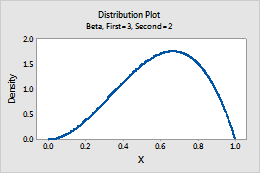
Minitab does not appear to have a way to use the "ones" trick to calculate a prediction interval for a univariate mean.Perform a t-test for a population mean µ.Calculate a t-interval for a population mean μ.For example, typing "2" will result in an area under the curve of 0.977250 to the left of 2 (corresponding to an upper-tail area of 0.02275). To calculate upper tail areas (p-values) for a standard normal distribution, select Calc > Probability Distributions > Normal, select "Cumulative probability," select "Input constant," and type an appropriate z-value into the "Input constant" box. Use probability plots to see your data and visually check model assumptions: Probability plots are simple visual ways of summarizing reliability data by plotting CDF estimates versus time using a log-log scale.To create a QQ-plot (quantile-quantile or normal probability plot), select Graph > Probability Plot, choose "Simple," and move "Price" into the "Graph variables" box.For example, typing "0.9" will result in the 90th percentile (corresponding to an upper-tail area of 0.1). To calculate percentiles (critical values) for a standard normal distribution, select Calc > Probability Distributions > Normal, select "Inverse cumulative probability," select "Input constant," and type an appropriate probability into the "Input constant" box.Determine summary statistics for a variable.To create a histogram, select Graph > Histogram, choose "Simple," and move "Price" into the "Graph variables" box.Similarly, ggplot's statqq () seems to present similar information with a transformed x axis.
NORMAL PROBABILITY PLOT MINITAB HOW TO
Unfortunately, I cannot figure out how to add the confidence interval bands around this plot. The probplot gets you most of the way there. Minitab describes this as a normal probability plot.

Joiner Solution See the link, Normal Probability Plots and Tests for Normality, below. The Minitab output will provide the confidence interval. We will first explore Normal probability plots using randomly generated data and then use these plots as a means of assessing the assumption of Normality made. Revised: Applies to Minitab 17 Minitab 16 Description Where can I find the paper 'Normal Probability Plots and Tests for Normality,' by Thomas A. Click on the variable (length for this example) and change to the desired confidence level.Choose Stat > Basic Statistics > 1-Sample t.Enter the 12 measurements into one column (name it length for this example).Minitab: Find the t-interval using Minitab Now, we can proceed to find the 90% t-interval for the mean length of rattlesnakes in the central Pennsylvania area since even though the sample size is less than 30, the normality plot shows that the data may come from a normal distribution. Since the points all fall within the confidence limits, it is reasonable to suggest that the data come from a normal distribution. The default format for probability plots in. What do you conclude about whether they may come from a normal distribution? A Probability Plot in Minitab serves the same purpose as a normal quantile plot as described in the text.

Here is the normal probability plot for the rattlesnake data. An informal approximation of a normality test, called 'the fat pencil test', is often applied to a probability plot. Type or upload the data in the first column in Minitab. Learn more about Minitab Statistical Software.Enter the 12 measurements into one column (name it length for this example) or upload the snakes.txt file.To create a normal probability plot in Minitab: Minitab: Creating a normal probability plot Therefore, let's do a normal probability plot to check whether the assumption that the data come from a normal distribution is valid. The scenario does not give us an indication that the lengths follow a normal distribution. is the number next to RJ in the box to the right of the graph. Think about what conditions you need to check. Using Minitab to run a RyanJoiner Test for Normality.


 0 kommentar(er)
0 kommentar(er)
